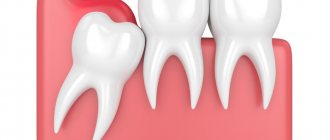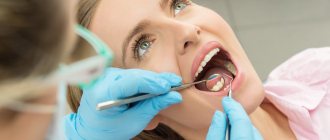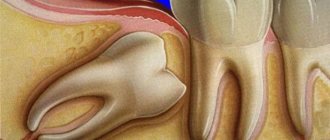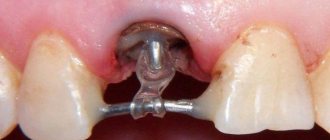For most people, the growth of wisdom teeth is accompanied not only by gum cutting and discomfort, but also by quite severe pain that makes it difficult to eat, concentrate on any task, and even sleep.
If the wisdom tooth grows and does not cause significant discomfort, no medical action may be taken. As a rule, the discomfort goes away after 1-2 weeks, but in order to avoid the manifestation of other problems, it is worth undergoing an examination at a dental clinic. However, if the gums from the wisdom tooth become inflamed, the local and general temperature rises, and specific aching pain is felt, immediately contact your dentist, he will conduct an examination and take the necessary measures to eliminate the problem.
Symptoms of wisdom tooth growth
During the period when a wisdom tooth comes in, a number of specific symptoms can be observed, by which it can be determined that the discomfort comes specifically from the eights:
- Discomfortable sensations in the tooth area, in some cases – gum thickening;
- Feeling of swelling in the gums;
- Increased local temperature, painful swelling;
- In the molar area, soft tissues (gums) become inflamed;
- Difficulty opening the mouth and swallowing. When opened wide, a sharp, aching pain is felt;
- There is a desire to chew any hard food or objects. After such chewing, the pain increases significantly;
- General increase in body temperature, general malaise and headaches.
Depending on the nature of growth, pain in wisdom teeth and specific symptoms can vary significantly. Regardless of how long a wisdom tooth grows - one or two weeks, it will cause certain sensations, and in case of complex or pathological growth - acute pain with inflammation of the gums.
An increase in general body temperature and swelling of the cheek indicates a severe course, as well as the possible development of pericoronitis - a complex disease of the oral cavity with a number of consequences.
Crowding of teeth and malocclusion
Due to the fact that there is usually not enough space for a growing wisdom tooth, it begins to prop up the adjacent molar and shift it towards the center, and it, in turn, also moves towards the center of the teeth adjacent to it. As a result, crowding of teeth occurs and their correct alignment is disrupted. If this process goes too far, the bite may be disrupted.
Pressure on the adjacent tooth
Quite often, as wisdom teeth grow, pain may occur (constant dull or intermittent), radiating to the ear, temple or lower jaw. If there are no external signs of inflammation (redness and swelling of the gums), then you need to take a photo of the tooth. After all, this is the only way to understand whether the wisdom tooth is growing correctly and whether it will be necessary to remove it.
Inflammation of the branches of the trigeminal nerve
The pathology is manifested by attacks of pain in the neck, as well as twitching of some muscles. Painful attacks can be triggered by normal daily activities such as washing, brushing teeth or shaving. Most often, the symptoms go away after the wisdom tooth is removed and proper anti-inflammatory treatment is administered.
Jaw cyst
Since the growth of a wisdom tooth occurs very slowly, it can cause the formation of a cyst in the lower jaw. In the event that the cyst does not grow, the course of the disease may be asymptomatic, and the cyst can be discovered by chance when a picture of the jaw is taken for completely different reasons. If the cyst grows, this causes pain in the area of the wisdom tooth. There may be an accumulation of fluid in the cyst, which will gradually corrode the walls of the teeth. If an infection gets into the cyst cavity, a gumboil (ulcer) of the wisdom tooth occurs. In this case, you can definitely answer that the “eight” must be removed.
The main causes of pain
Painful symptoms from wisdom teeth are caused by the anatomical features of the upper and lower jaw, which are already fully formed in a person at the age of 17-25.
As the figure eight begins to grow, it puts pressure on neighboring teeth, bone and soft tissue. The growth process can last for months and even years, so pain manifestations are temporary, periodically fading and exacerbating.
The pain of tooth 8 can be provoked not only by its growth or anatomically incorrect position, but also by the presence of various pathologies, for example, caries, pulpitis, periodontitis or a wide range of infectious diseases. Note! The lack of timely professional help can provoke a worsening of the situation, which will result in the need to remove the diseased tooth and treat complications.
Complications associated with teething
With pathological germination of the figure eight, a number of complications can develop. A common disorder is pericoronitis. The disease is associated with inflammation of the tissues of the jaw and mucous membranes of the mouth.
Characteristic signs of pericoronitis:
- the appearance of severe swelling and redness in the eruption area;
- sore throat when swallowing;
- deterioration of health;
- weakness;
- temperature increase;
- discharge of purulent masses when pressing on the gums.
Often pericoronitis becomes chronic, which is accompanied by pain and discomfort when pressing on the problem area. An abscess may form in place of the tooth.
Carious lesion is another consequence of improper eruption of figure eights. The fact is that the last molars may fit too tightly to the sevens, which makes it difficult to naturally clean the dental space from plaque and bacteria. As a result, caries develops with all its characteristic symptoms:
- darkening of the enamel;
- pain when chewing;
- tooth sensitivity.
Sometimes it happens that the figure eight comes out on the surface of the already affected gum.
Periodontitis appears after the eruption of the last molar. The pathology is characterized by inflammation of the gums due to the inconvenient location of the wisdom tooth in the gum. In this case, plaque and bacteria from the oral cavity are almost impossible to remove using standard hygiene measures. Bacteria in the space between the gum and tooth provoke inflammation and swelling of the soft tissues of the mouth. If a visit to the dentist is untimely, periodontitis is complicated by gumboil or periostitis.
What to do if a wisdom tooth comes out and your gums hurt
Symptoms of flux manifest clearly and are accompanied by:
- temperature rise to 40 degrees;
- swollen cheeks;
- swelling spreading to most of the face;
- intoxication of the body;
- excruciating pain.
As a result of abnormal eruption of the figure eight, a cyst can grow - a benign tumor filled with clear liquid. It contains particles of dead cells, bacteria and food debris. You can notice a cyst by protruding gums and discomfort when chewing food. Rarely, a cyst is accompanied by severe pain.
The appearance of a wisdom tooth above or below can cause damage to the trigeminal nerve. If it is violated, there is involuntary twitching of the face and severe sharp pain. In severe cases, facial paralysis may occur.
Abscess is one of the most severe complications associated with the pathological eruption of the last elements. It develops in the most patient patients. Among the signs of the disease are:
- sharp putrid odor from the mouth;
- constant feeling of bitterness;
- heat;
- throbbing pain.
When the abscess goes inside, phlegmon or an extensive inflammatory process develops. Swelling spreads to the entire face.
Cellulitis is a complication that can cause the patient’s death
You need to be attentive to all the symptoms that manifest the eruption of wisdom teeth. If pain persists for more than 2-3 days, then you need to seek help from a dentist. It is recommended to independently relieve the symptoms of the condition only if it is not possible to visit a specialist. For this purpose, it is permissible to use painkillers and traditional medicine. During a visit to the doctor, it is necessary to tell you that pain relief measures were taken regarding the problem unit.
How to relieve pain if a wisdom tooth grows and your gums hurt.
The growth of wisdom teeth is not painless for every person, so most people need to know what to do in case of inflammation of the gums around the wisdom tooth and acute aching pain.
If there is inflammation, pain, or if the cheek is swollen near the wisdom tooth, you should contact your dentist, he will conduct an examination and take the necessary measures to eliminate symptomatic manifestations.
If the pain begins in the evening or it is not possible to quickly contact a specialized specialist, doctors recommend several ways to reduce pain:
- Rinse the growth with calendula tincture after eating - this will reduce the intensity of the inflammatory process and also reduce pain;
- Rinse your mouth with a solution of baking soda in water, at the rate of 1 teaspoon of soda per 1 glass of water (200 grams) - soda calms inflammation and also reduces pain;
- To rinse the mouth, you can use decoctions of chamomile, oak bark, chicory root, as well as sage tincture and propolis;
- Anti-inflammatory, painkillers and antibacterial drugs - use according to the instructions. They help reduce pain, reduce swelling, and also eliminate the negative bacterial influence at the site of tooth eruption.
In case of acute unbearable pain, as well as the absence of the above remedies, you can use cold water to reduce pain: take a glass of cool water, put a small amount in your mouth and hold it in the area where the wisdom tooth is erupting - this can quickly reduce the level of pain. However, this method has one negative feature - the pain intensifies almost immediately after stopping holding cool water at the site of gum inflammation, for example, near the hood of a wisdom tooth.
How to understand that a wisdom tooth is cutting?
For many, “eights” erupt without causing complaints. But since the sharp edges of the crown irritate the nerve endings of the gums, the following symptoms occur:
- Soreness or dull throbbing pain;
- Swelling of the gums, which can be felt with the tongue;
- Saliva mixed with blood;
- “Gum hood”, that is, raised gum above the crown of the tooth.
The pain intensifies when a person chews, opens his mouth, or lies down. In people with a low pain threshold, it can be severe, even if the tooth grows correctly and does not encounter obstacles.
If the third molar cannot “break through” the soft tissue, pericoronitis occurs - inflammation of the gum above the crown. The tooth injures the mucous membrane, tears form in it, in which food particles and bacteria accumulate, causing inflammation. Pus forms under the “gum hood” and can be released into the oral cavity.
If pus spreads to the periodontal tissues and bone, periostitis occurs - a flux that causes the following symptoms:
- The mucous membrane becomes cyanotic;
- The cheek is swollen;
- The pain becomes unbearable and intensifies when you try to open your mouth;
- The patient cannot eat;
- The parotid and submandibular lymph nodes are enlarged;
- Body temperature rises to 38°C.
When the swelling spreads to the cheek, palate and throat, the patient experiences difficulty swallowing. Severe pain is disturbing if the “eight” does not fit in the jaw, grows at an angle, or displaces and compresses the neighboring tooth, the “seven”. Because of this, the bite may change, and caries may appear on the neighboring “seven”.
Where can I get dental care in Orenburg?
If your gums hurt where your wisdom teeth are, you can get qualified dental care in two places: public and private dental clinics. During the appointment, the dentist must:
- Conduct a preliminary examination of the oral cavity, determine the exact cause of the development of painful symptoms;
- If necessary, refer the patient for an x-ray - this procedure is often necessary in the presence of impacted wisdom teeth (completely or partially covered by gum), as well as in the case of surgical removal;
- Take the necessary measures to reduce or eliminate pain and swelling, as well as prevent further aggravation of the situation;
- If necessary, refer to a dental surgeon to remove third molars;
- Provide recommendations for further dental and oral care.
Do your gums hurt and you have symptoms of wisdom tooth growth? Seek qualified help from specialized specialists!
At what age do wisdom teeth erupt?
Milk teeth are replaced by permanent teeth starting from the age of 6, this process ends around 12-13 years. The eruption of wisdom teeth most often occurs no earlier than 16-25 years of age. True, the literature describes cases where wisdom teeth erupted at the age of 40. But such cases are extremely rare.
Why did wisdom teeth get such a name?
Permanent teeth begin to erupt in a child at the age of 6-7 years, and the eruption of wisdom teeth occurs at the age of 16-25 years. It is by the age of 25 that the growth of all organs and systems of the human body, as well as their development, has completely ended, and then the process of aging of the body begins. Thus, the time when the eruption of the eighth teeth occurs can be considered the period of maturity of the organism, hence the last permanent eighth teeth got their name.
Complications resulting from the growth of “wise teeth”
- Malocclusion and crowded dentition.
In this case, the eighth tooth simply does not have room for normal eruption and placement. - Pressure and damage to the adjacent tooth.
If there is not enough room for the eight to grow, it begins to push against its neighbors. - Pericoronitis.
When the eruption of the figure eight is difficult, the soft tissues in this area become inflamed due to the activity of pathogenic bacteria. A so-called gum hood forms over the tooth, in which food debris accumulates, which provokes infection. The main syndrome is severe aching pain, inflammation, and sometimes purulent discharge. - Inflammation of the trigeminal nerve.
Incorrect position of the wisdom tooth can affect the trigeminal nerve, which manifests itself in the form of pain and uncontrollable twitching of the facial muscles. - Osteomyelitis and dental cyst.
Eighth tooth, figure eight, third molar: how many wisdom teeth does a person have?
In the modern world, wisdom teeth are considered something of a rudiment, that is, an organ that has lost its significance in the process of evolutionary development. That is why their appearance is greatly delayed or may not take place at all. As a rule, an adult has a maximum of 32 teeth, including 4 wisdom teeth.
However, a person can have more than 4 wisdom teeth - such cases occur quite often in dental practice! Two or more wisdom teeth may erupt, or none may appear: it all depends on the individual characteristics of the body and the structure of the dentofacial apparatus. Although a set of 32 molars is considered ideal, a number of 28 to 32 is also considered normal.
Differences between upper and lower wisdom teeth
Compared to the upper ones, the lower “eights”, as a rule, have a larger number of root canals. In addition, their removal is more difficult because the bone tissue in the lower jaw is considered denser. Otherwise, there are no significant differences.











